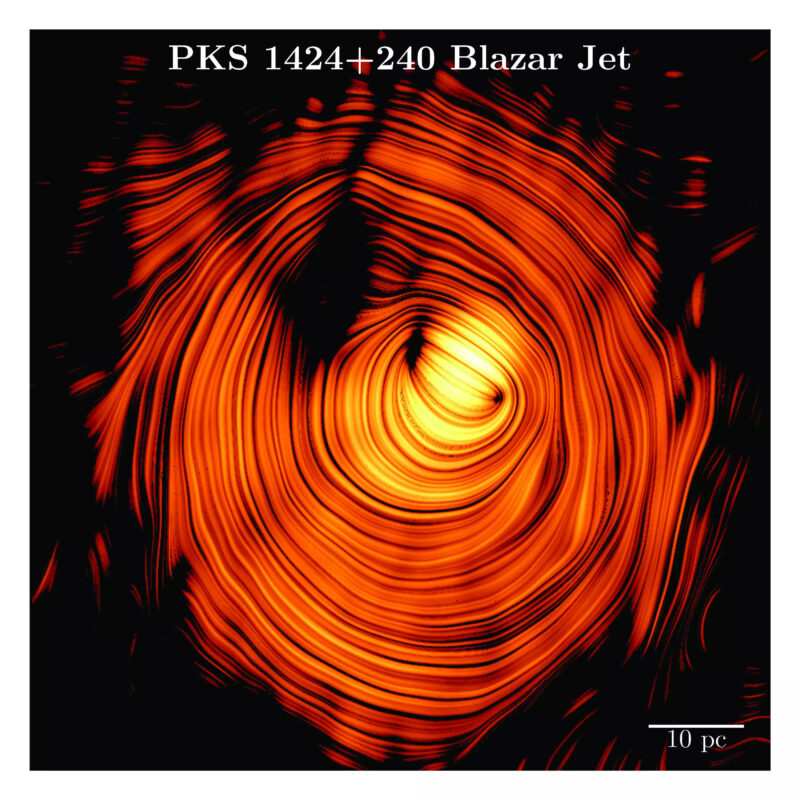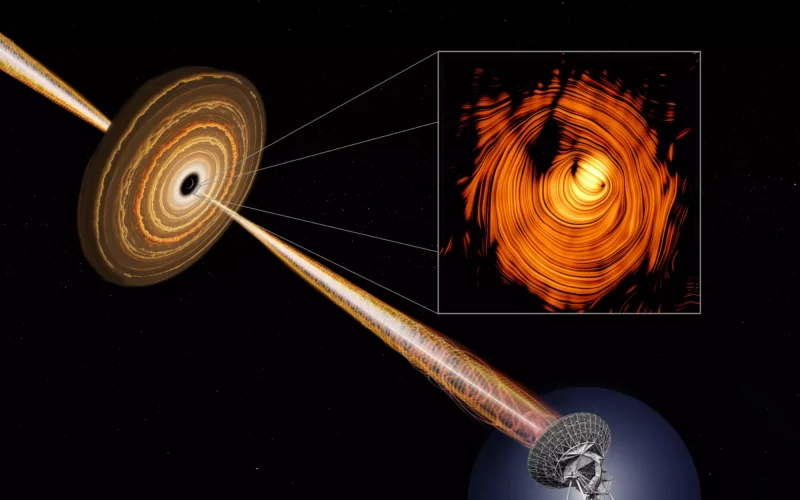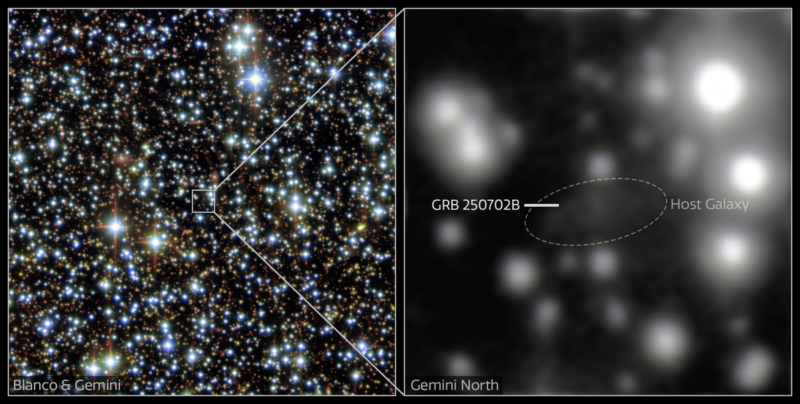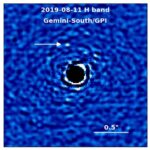Now Reading: ‘Eye of Sauron’ blazar is source of a powerful cosmic jet
-
01
‘Eye of Sauron’ blazar is source of a powerful cosmic jet
‘Eye of Sauron’ blazar is source of a powerful cosmic jet


- Astronomers have captured an image of the origin of a cosmic jet. The image and its artificial coloring recall the Eye of Sauron from the Lord of the Rings.
- PKS 1424+240 is the brightest neutrino-emitting object of its kind. However, the concentrated mass flow is too slow to explain the emission of neutrinos.
- Years of precise observations have enabled a detailed analysis of the jet’s origin. The radio image shows ring-shaped magnetic fields, an environment that acts like a spring and can accelerate particles to high energies. This in turn explains neutrinos and high-energy gamma radiation.
Astronomers spot ‘Eye of Sauron’ in deep space
A look into the throat of an active galaxy’s nucleus has revealed a ring-shaped magnetic field that looks strikingly like the Eye of Sauron as depicted in film versions of The Lord of the Rings by J.R.R. Tolkien. The researchers at the Max Planck Institute said on August 12, 2025, that the image stunned them. Its likeness to the classic fantasy image is in part due to artificial coloring. The new study might help explain extreme gamma radiation and neutrinos.
PKS 1424240 is the brightest neutrino-emitting object of its kind. (Neutrinos are almost massless and almost noninteracting elementary particles of matter.) However, the concentrated mass flow is too slow to explain the emission of neutrinos.
Spiral magnetic fields, however, accelerate particles. And 15 years of precise observations with the Very Long Baseline Array have enabled a detailed analysis of the jet’s origin. The radio image could solve this problem. It shows ring-shaped magnetic fields, an environment that acts like a spring and can accelerate particles to high energies. This in turn explains neutrinos and high-energy gamma radiation.
The astronomers published their peer-reviewed results in Astronomy & Astrophysics on August 12, 2025.

The Eye of Sauron posed a high-energy puzzle for years
Located billions of light-years away, the blazar PKS 1424+240 had long baffled astronomers. It stood out as the brightest known neutrino-emitting blazar in the sky as identified by the IceCube Neutrino Observatory. The ground-based Cherenkov telescopes also observed it glowing in very high-energy gamma rays. Yet, oddly, its radio jet appeared to move sluggishly. And that contradicted expectations that only the fastest jets can power such intense high-energy emissions.
A blazar is a type of active galactic nucleus powered by a supermassive black hole that launches a jet of plasma moving at nearly light speed. What makes a blazar special is its orientation: one of its jets is pointed within about 10 degrees of Earth. This alignment makes blazars appear bright across the electromagnetic spectrum. And it allows scientists to study extreme physical processes, including the acceleration of particles to energies far beyond those achieved in human-made accelerators.
Now, thanks to 15 years of ultra-precise radio observations from the Very Long Baseline Array, researchers have stitched together a deep image of this jet at unparalleled resolution.
Yuri Kovalev is the lead author of the study and Principal Investigator of the ERC-funded MuSES project at the Max Planck Institute for Radio Astronomy. Kovalev said his research team were taken aback by the image they produced:
When we reconstructed the image, it looked absolutely stunning. We have never seen anything quite like it – a near-perfect toroidal magnetic field with a jet, pointing straight at us.

Blazar jet is energized by special relativity
The jet is aligned almost exactly in the direction of Earth. So its high-energy emission is dramatically amplified by the effects of special relativity. Special relativity is the famous theory by Albert Einstein that united space and time into spacetime. Spacetime defined the speed of light as a constant and established that physical laws are the same regardless of one’s frame of reference.
Co-author Jack Livingston explained:
This alignment causes a boost in brightness by a factor of 30 or more. At the same time, the jet appears to move slowly due to projection effects – a classic optical illusion.
This head-on geometry allowed scientists to peer directly into the heart of the blazar’s jet. This was an extremely rare opportunity. Polarized radio signals helped the team map out the structure of the jet’s magnetic field, revealing its likely helical or toroidal shape. This structure plays a key role in launching and collimating the plasma flow. And it may be essential for accelerating particles to extreme energies.
Kovalev explained:
Solving this puzzle confirms that active galactic nuclei with supermassive black holes are not only powerful accelerators of electrons, but also of protons — the origin of the observed high-energy neutrinos.
The MOJAVE program
The discovery is a triumph for the MOJAVE program, a decades-long effort to monitor relativistic jets in active galaxies using the Very Long Baseline Array. Scientists employ the technique of Very Long Baseline Interferometry, which connects radio telescopes across the globe to form a virtual telescope the size of the Earth. This provides the highest resolution available in astronomy, allowing them to study the fine details of distant cosmic jets.
Anton Zensus, director at Max Planck Institute for Radio Astronomy and co-founder of the MOJAVE program said:
When we started MOJAVE, the idea of one day directly connecting distant black hole jets to cosmic neutrinos felt like science fiction. Today, our observations are making it real.
This result strengthens the link between relativistic jets, high-energy neutrinos, and the role of magnetic fields in shaping cosmic accelerators. And it marks a milestone in multi-messenger astronomy.
Bottom line: Astronomers have captured an image of the origin of a cosmic jet. The image and its artificial coloring resemble the “Eye of Sauron” from the Lord of the Rings.
Source: Looking into the jet cone of the neutrino-associated very high-energy blazar PKS 1424+240
Read more: Rare neutrinos detected from under Antarctic ice
The post ‘Eye of Sauron’ blazar is source of a powerful cosmic jet first appeared on EarthSky.
Stay Informed With the Latest & Most Important News
Previous Post
Next Post
-
 012024 in Review: Highlights from NASA in Silicon Valley
012024 in Review: Highlights from NASA in Silicon Valley -
 02Panasonic Leica Summilux DG 15mm f/1.7 ASPH review
02Panasonic Leica Summilux DG 15mm f/1.7 ASPH review -
 03From Polymerization-Enabled Folding and Assembly to Chemical Evolution: Key Processes for Emergence of Functional Polymers in the Origin of Life
03From Polymerization-Enabled Folding and Assembly to Chemical Evolution: Key Processes for Emergence of Functional Polymers in the Origin of Life -
 04How New NASA, India Earth Satellite NISAR Will See Earth
04How New NASA, India Earth Satellite NISAR Will See Earth -
 05And Thus Begins A New Year For Life On Earth
05And Thus Begins A New Year For Life On Earth -
 06Astronomy Activation Ambassadors: A New Era
06Astronomy Activation Ambassadors: A New Era -
07SpaceX launch surge helps set new global launch record in 2024




















